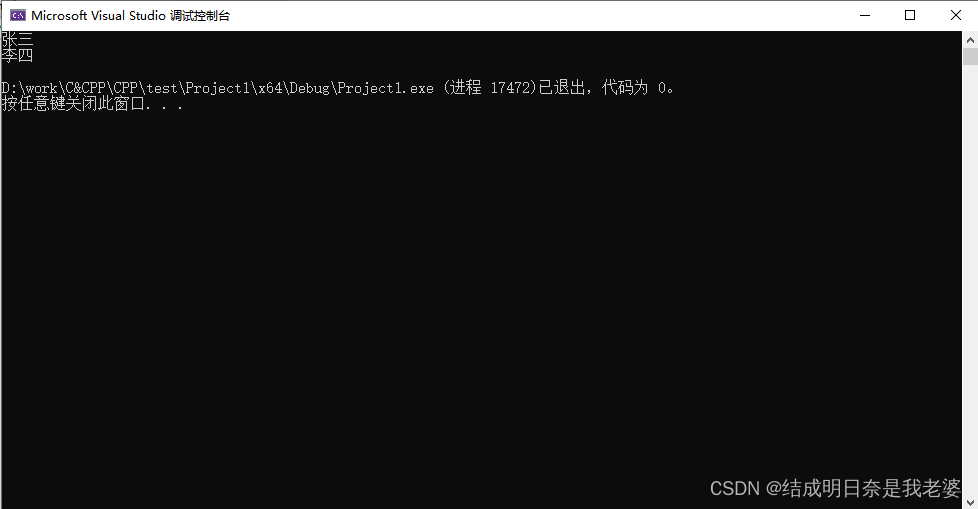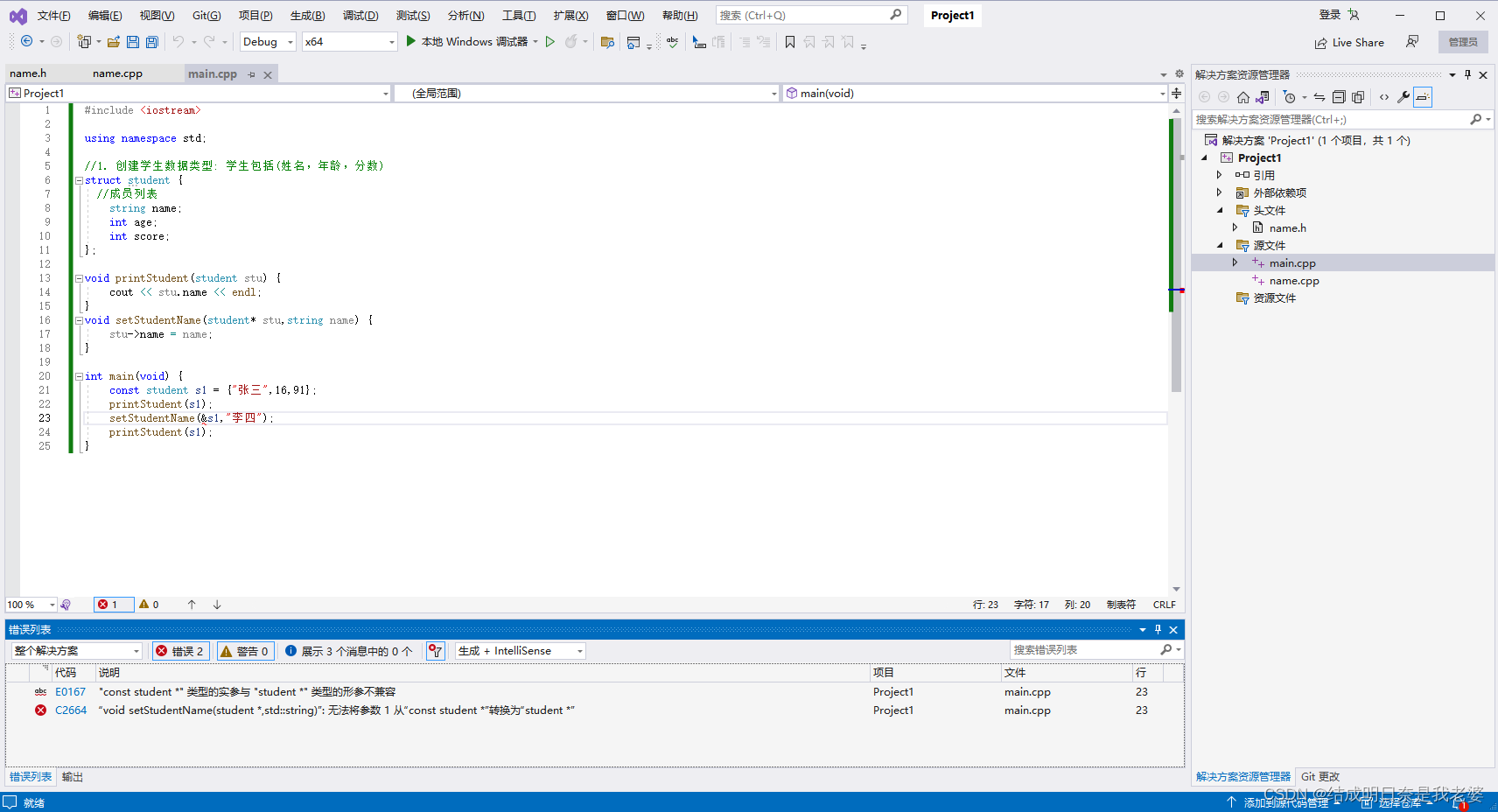结构体是属于用户自定义的数据类型,允许用户存储不同的数据类型
结构体定义和使用
语法:
struct 结构体名称{结构体成员列表};
定义
//1. 创建学生数据类型: 学生包括(姓名,年龄,分数)
struct Student {
//成员列表
string name;
int age;
int score;
};
使用
struct Student s1;struct Student s2 = {....};
#include <iostream>
using namespace std;
//1. 创建学生数据类型: 学生包括(姓名,年龄,分数)
struct Student {
//成员列表
string name;
int age;
int score;
};
int main(void) {
struct Student s1;
//通过结构体变量.变量中的属性
s1.name = "李四";
s1.age = 18;
s1.score = 90;
cout << "学生1姓名:" << s1.name << "年龄:" << s1.age << "分数:" << s1.score << endl;
struct Student s2 = {
"王五",19,95 };
cout << "学生2姓名:" << s2.name << "年龄:" << s2.age << "分数:" << s2.score << endl;
}
结构体数组
学生量比较大的时候就可以考虑放入一个数组中
语法:
struct 结构体名称 数组名[元素个数] = { {},{},{},....}
#include <iostream>
using namespace std;
//1. 创建学生数据类型: 学生包括(姓名,年龄,分数)
struct Student {
//成员列表
string name;
int age;
int score;
};
int main(void) {
struct Student stuArray[3] = {
{
"张三",18,80},
{
"李四",19,88},
{
"王五",19,79}
};
//修改元素
stuArray[2].name = "赵四";
stuArray[2].age = 20;
stuArray[2].score = 60;
for (int i = 0; i < 3; i++) {
cout << "学生1姓名:" << stuArray[i].name << "年龄:" << stuArray[i].age << "分数:" << stuArray[i].score << endl;
}
}
结构体指针
#include <iostream>
using namespace std;
//1. 创建学生数据类型: 学生包括(姓名,年龄,分数)
struct Student {
//成员列表
string name;
int age;
int score;
};
int main(void) {
//1. 创建学生结构体变量
struct Student s = {
"张三",18,100 };
//2. 通过指针指向结构体变量
Student* p = &s;
//3. 通过指针访问结构体变量中的数据
cout << p->name << endl;
}
结构体嵌套结构体
#include <iostream>
using namespace std;
//1. 创建学生数据类型: 学生包括(姓名,年龄,分数)
struct student {
//成员列表
string name;
int age;
int score;
};
struct teacher {
int id;
string name;
student stu;
};
int main(void) {
student s1 = {
"张三",18,65 };
teacher t1 = {
0,"王老师",s1 };
cout << "老师的名称:" << t1.name << "带的学生名字:" << t1.stu.name << endl;
}
结构体做函数参数
值传递
#include <iostream>
using namespace std;
//1. 创建学生数据类型: 学生包括(姓名,年龄,分数)
struct student {
//成员列表
string name;
int age;
int score;
};
void printStudent(student stu) {
cout << stu.name << endl;
}
int main(void) {
student s1 = {
"张三",16,91};
printStudent(s1);
}
地址传递
#include <iostream>
using namespace std;
//1. 创建学生数据类型: 学生包括(姓名,年龄,分数)
struct student {
//成员列表
string name;
int age;
int score;
};
//将形参改为指针,可以减少内存空间
void printStudent(student *stu) {
cout << stu.name << endl;
}
void setStudentName(student* stu,string name) {
stu->name = name;
}
int main(void) {
student s1 = {
"张三",16,91};
printStudent(&s1);
setStudentName(&s1,"李四");
printStudent(&s1);
}

结构体中const使用场景
这个防止我们误操作
其实就是防止我们有写的操作
#include <iostream>
using namespace std;
//1. 创建学生数据类型: 学生包括(姓名,年龄,分数)
struct student {
//成员列表
string name;
int age;
int score;
};
void printStudent(student stu) {
cout << stu.name << endl;
}
void setStudentName(student* stu,string name) {
stu->name = name;
}
int main(void) {
const student s1 = {
"张三",16,91}; //加上了const
printStudent(s1);
setStudentName(&s1,"李四");
printStudent(s1);
}

一旦有改变元素的行为就会报错